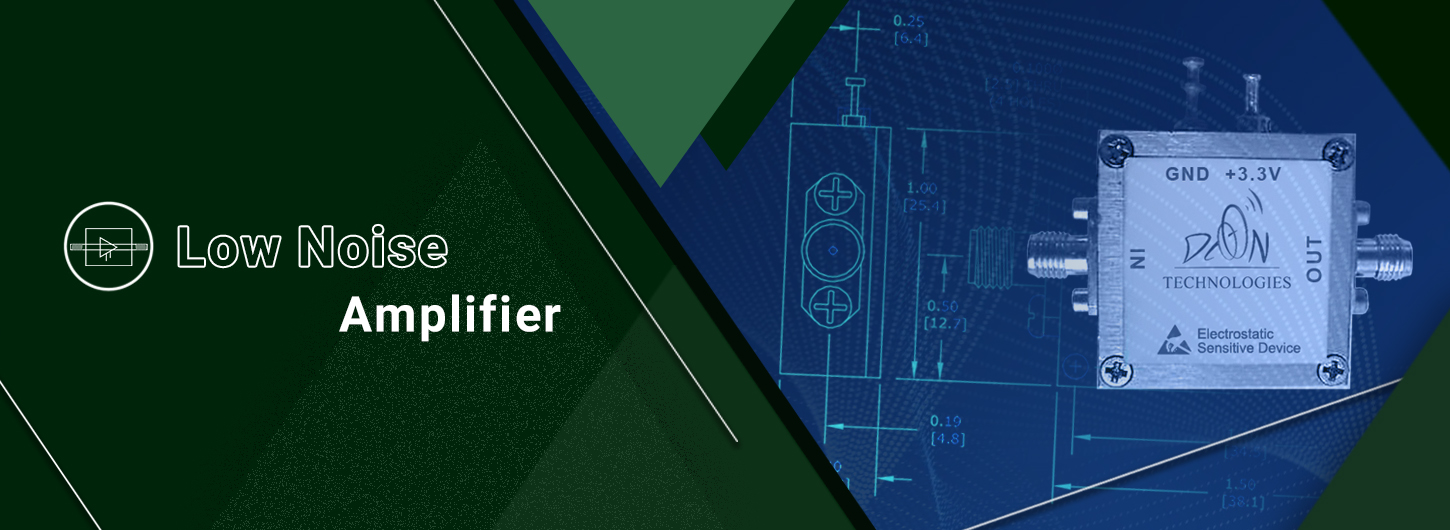
A low-noise amplifier (LNA) is an electronic amplifier that amplifies a very low-power signal without significantly degrading its signal-to-noise ratio. An amplifier will increase the power of both the signal and the noise present at its input, but the amplifier will also introduce some additional noise. LNAs are designed to minimize that additional noise. Designers can minimize additional noise by choosing low-noise components, operating points, and circuit topologies. Minimizing additional noise must balance with other design goals such as power gain and impedance matching.
Dioon Technology LNAs are found in radio communications systems, medical instruments and electronic test equipment. A typical LNA may supply a power gain of 100 (20 decibels (dB)) while decreasing the signal-to-noise ratio by less than a factor of two (a 3 dB noise figure (NF)). Although LNAs are primarily concerned with weak signals that are just above the noise floor, they must also consider the presence of larger signals that cause intermodulation distortion.
In the RF (Radio Frequency) and microwave category, LNA stands for Low Noise Amplifier. An LNA is a specialized amplifier designed to amplify weak signals while introducing minimal additional noise to the signal. LNAs are commonly used in RF and microwave systems to improve the signal-to-noise ratio (SNR) and enhance the sensitivity of receivers. Here's some information about LNAs:
- Signal Amplification: The primary function of an LNA is to amplify weak signals without introducing significant additional noise. LNAs are typically placed at the front end of a receiver chain to boost the received signal's power level before further processing and demodulation. They provide gain to overcome the losses in subsequent stages of the system and improve the overall system sensitivity.
- Low Noise Figure: LNAs are designed to have a low noise figure, which is a measure of the additional noise introduced by the amplifier. The lower the noise figure, the less noise is added to the signal during amplification. LNAs aim to minimize noise contribution to maintain the integrity and quality of the received signal.
- High Linearity: LNAs strive to provide high linearity to avoid distortion and intermodulation effects. Linearity refers to the ability of the amplifier to reproduce the input signal faithfully at the output without introducing nonlinear distortions. High linearity is crucial in applications where the received signal contains multiple frequency components or where the amplifier may be exposed to strong interfering signals.
- Gain and Stability: LNAs provide gain, which is the ratio of the output signal power to the input signal power. The gain of an LNA helps compensate for signal losses and improves the SNR. Additionally, LNAs are designed to maintain stability, ensuring consistent performance across various operating conditions and frequencies.
- Frequency Range: LNAs are available in a wide range of frequency options, covering RF and microwave frequencies. The specific frequency range of an LNA depends on the application requirements, such as cellular communication, satellite communication, radio astronomy, and more.
- Noise Figure and Gain Trade-off: LNAs typically exhibit a trade-off between noise figure and gain. Increasing the gain of an LNA often leads to a higher noise figure, as amplifying the signal also amplifies the inherent noise. Designers aim to strike a balance between achieving sufficient gain and maintaining a low noise figure based on the specific application's requirements.
- Power Supply and Biasing: LNAs require appropriate power supply and biasing to operate correctly. Biasing circuits ensure the amplifier is properly biased and optimized for performance. Power supply requirements, such as voltage and current, depend on the specific LNA design and application.
LNAs are essential components in RF and microwave systems, particularly in receiver chains, where amplification of weak signals is necessary. They are utilized in various applications, including wireless communication, radar systems, satellite communication, scientific research, and more, to enhance the sensitivity and overall performance of the system.
A low-noise amplifier (LNA) is an electronic device used to amplify weak signals while introducing minimal additional noise. It is commonly employed in communication systems and signal processing applications where the incoming signals are weak and need to be amplified without degrading the overall signal quality.
Key characteristics and features of a low-noise amplifier include:
- Amplification: The primary function of an LNA is to amplify weak signals. It boosts the amplitude of the input signal to a level that can be easily processed by subsequent stages in the system.
- Noise Figure: The noise figure is a measure of how much additional noise the amplifier introduces to the signal. LNAs are specifically designed to have a low noise figure, meaning they add minimal noise to the input signal during the amplification process. This ensures that the overall signal-to-noise ratio (SNR) is maintained or improved.
- Frequency Band: LNAs are designed to operate within specific frequency bands. They can be tailored for various frequency ranges, such as radio frequency (RF), microwave, or even higher frequency ranges.
- Impedance Matching: To optimize the power transfer and minimize signal reflections, LNAs often include impedance matching circuits that match the impedance of the amplifier to the input and output circuits.
- Gain Control: Some LNAs feature gain control mechanisms that allow for adjustable amplification levels. This enables dynamic control over the amplification based on changing signal conditions.
- Low Power Consumption: Many LNAs are designed to operate with low power consumption to minimize energy requirements in battery-powered devices or reduce overall system power consumption.
- High Linearity: LNAs may incorporate techniques to maintain linearity, ensuring that the amplified signal faithfully represents the input signal and prevents distortion or nonlinear effects.
Applications of low-noise amplifiers include:
- Communication Systems: LNAs are used in wireless communication systems, such as cellular networks, satellite communication, wireless LANs, and radio receivers, to amplify weak incoming signals from antennas.
- Radar Systems: LNAs are essential in radar systems to amplify the weak radar return signals for accurate target detection and tracking.
- Medical Imaging: LNAs are utilized in medical imaging systems, such as magnetic resonance imaging (MRI) or ultrasound, to amplify the weak signals received from the patient's body.
- Sensor Systems: LNAs are employed in various sensor applications where weak signals need to be amplified, such as in environmental monitoring, scientific instrumentation, or industrial control systems.
Overall, low-noise amplifiers play a critical role in improving signal quality and enhancing the sensitivity and performance of electronic systems by amplifying weak signals while maintaining low noise levels.
